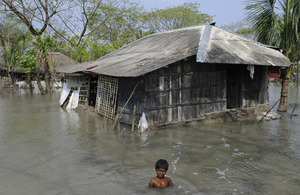DFID Research: Manifesto for the extreme poor
The Economic Empowerment of the Poorest Programme (EEP) is working in Bangladesh to help understand extreme poverty and to develop effective strategies for social empowerment and economic growth.

Picture: Rafiqur Rahman Raqu /DFID
In February of this year the High Level Panel on the Post 2015 Development Agenda (HLP) met in Monrovia, Liberia to discuss how to tackle global poverty. Extreme poverty was highlighted as a core issue in the statements arising from the conference.
In early 2012 the World Bank released the aggregated regional statistics of the developing world’s poverty estimates for 1981-2008. This data demonstrated that extreme poverty was falling indicating that the first Millennium Development Goal of halving extreme poverty by 2015 was likely to be achieved.
Despite this positive news, the data revealed that a large proportion of people are now living just above the extreme poverty line, making them a particularly vulnerable group liable to slipping back into the extreme poverty bracket.
The Shiree/Economic Empowerment of the Poorest Programme (EEP) is a challenge fund set up by DFID and the Government of Bangladesh (GoB) specifically to enable work with extreme poverty in Bangladesh. It currently funds 36 different projects targeting vulnerable populations.
A recent working paper released by Shiree presented findings from qualitative and quantitative research conducted in the southwest coastal region of Bangladesh. The research focused on the challenges faced, and achievements made by disabled individuals living in extreme poverty who are undertaking income-generating activities.
The findings from this research highlight a number of important issues arising from the experiences of disabled people and their families, which have implications for policy makers and practitioners working to facilitate poverty reduction amongst this group..
The paper unpacks some of the issues discussed in their current development of the manifesto for the extreme poor. Launched in 2012, this manifesto focuses on 6 core themes which have emerged from Shiree’s own experience of working in approximately 200,000 extremely poor households.
Collecting recommendations from a wide variety of stakeholders the aim of the manifesto is to provide political actors and policy-makers with a credible document that articulates the real challenges and obstacles impeding the economic recovery of certain vulnerable groups.
The themes are outlined on their webpage as:
- exclusion from public services
- insufficient economic opportunities
- vulnerability to external shocks
- health and Nutrition vulnerability
- gender inequity
- marginalized group specific risks and vulnerabilities
In a video, 25 Million Voices- Stories from the Extreme Poor of Bangladesh, individuals living in extreme poverty voice their own concerns, highlighting daily problems faced in these communities.
The manifesto is still open for recommendations and aims to promote further dialogue around how these challenges can be faced and eradicated in the future. The second half of this year will see the public dissemination of the final document in English and Bangla and aims to outline realistic actions designed to reduce the bottleneck identified by the World Bank and to facilitate a pathway out of extreme poverty after 2015.